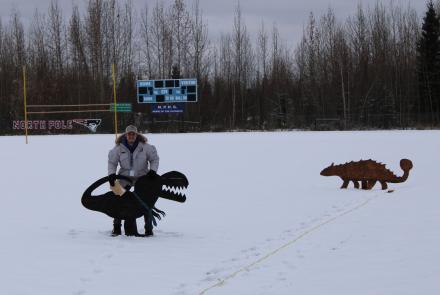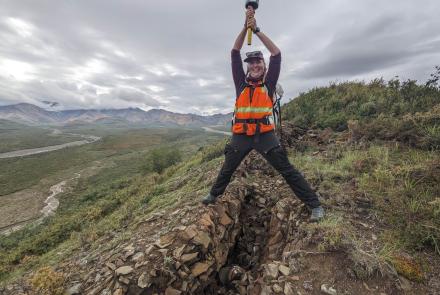Meet master's student Robin Carbaugh
Robin Carbaugh has had quite the successful three years at the University of Alaska Fairbanks.
She’s just wrapped up her master’s in sedimentology, with a thesis focusing on the Triassic-Jurassic boundary. She’s spent time in remote Alaska doing geologic research.
She interned with the state Division of Geological and Geophysical Surveys in the summers of 2022 and 2023. That sent her into the field to help answer some basic geologic questions such as the age of rocks and defining geologic age layers.
Since then she has been working full-time in the division’s Hydrology & Surficial Geology Section as a geologist II while finishing her master’s work through the UAF College of Natural Science and Mathematics.
And she will soon head to Anchorage to intern with ConocoPhillips.
It all started with a supposedly boring high school class.
•••
Garnet Valley High School, home of the Jaguars, is in the town of Glen Mills, Pennsylvania, about 30 road miles west of Philadelphia and was settled by Europeans in the 17th century. It’s an unincorporated community of about 22,000 people today in Concord Township.
A friend who had taken the high school geology class that Carbaugh had signed up for told her the class was boring.
“So I went into the class thinking I was going to hate it,” she said, “and then ended up falling in love with the subject.”
“What excited me about it was the mystery behind it,” she said. “That it's a puzzle, that you can find these rocks out there and they're time capsules in that they have a story behind them.”
From just one little rock, she marveled, loads of data can be had.
“You can get what environment it formed under, what the oxygen level was in the atmosphere at the time it was deposited,” she said. “There's just a whole story to be had.”
And then there was the trip to the Grand Canyon that summer with parents Steven and Alice and siblings Erin and Sean.
The family’s visit to that great chasm — 277 miles long, 18 miles wide at its greatest point, and a mile deep — cemented her love of geology. She didn’t want to give it up.
What hadn’t clicked at that point was geology’s career potential.
“In my mind, I'm like, ‘Well, it was just a class and it's over now,” she said.
Cue her mother.
“My mom said, ‘Well isn't geology a job? Something people do?’,” she said. “So it was like a light bulb moment. I thought, ‘Oh, I can pursue this and go into it.”
•••
Carbaugh’s outdoor “office” as a state geologist is rather expansive.
“I mostly do my fieldwork on the North Slope,” she said. “We go out in the summer to collect samples and then do the analysis work and the write-ups through the cold winter.”
Sedimentary rock formations dominate the North Slope. Many of these rocks were deposited during the Mesozoic and Cenozoic eras, including the Cretaceous, Jurassic and Triassic periods — as far back as 250 million years ago.
The region’s rocks largely include sandstone, shale and limestone, although there are also areas of metamorphic and igneous rocks.
More recently — during the Pleistocene epoch, about 2.5 million years ago — the North Slope was covered by glaciers that deposited sediments such as till and moraines.
The boundary between the Triassic and Jurassic periods caught Carbaugh’s attention because it is one of the five major global mass extinction events. It is well-documented globally, but not so well in Alaska.
The boundary between those two periods sits at about 200 millions years ago on the geologic timeline.
Several factors are believed to have caused the extinction: a massive volcanic event at the central Atlantic magmatic province, climate change related to that event, and habitat loss due to sea level changes as the supercontinent Pangaea broke apart.
“It was worldwide and impacted everything,” Carbaugh said. “Studies into it are useful because environmental impacts seen in the Triassic are similar today. There was extensive volcanism at the time that released abundant CO2, which for human-induced reasons is recorded today as well.”
For her master’s thesis, she sought to find the Triassic-Jurassic boundary with carbon isotopes, fossils, and geochemical analyses to better understand the environment at the time. She did that under the guidance of her advisor, Professor Michael Whalen of the College of Natural Science and Mathematics and of the UAF Geophysical Institute.
She focused specifically on the late Triassic Otuk Formation in northern Alaska. Her work entailed isotopic, geochemical and petrographic analysis to gain a better understanding of the depositional environments in which the Otuk Formation formed and identify its petroleum potential.
Does she have a favorite type of rock?
“I do sedimentary work, so most of the rocks that I look at are shales, like deep marine rocks,” she said. “They're, I guess, pretty boring in appearance, but I like the story they can tell.”
•••
Carbaugh said UAF has opened a lot of doors for her.
“The geologic research coming out of UAF is very applicable to other organizations doing work out here,” she said. “A lot of people love to hire UAF and UAA students since it is such a unique landscape.”
She says Alaska is a great place for geology.
“It has a little bit of everything, every type of rock from igneous, metamorphic to sedimentary, it's here. If you're into glacial work, it's here.”
Rod Boyce, University of Alaska Fairbanks Geophysical Institute, 907-474-7185, rcboyce@alaska.edu




